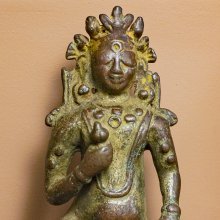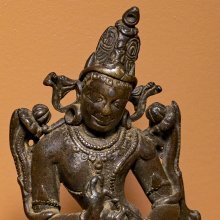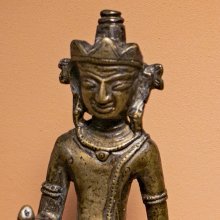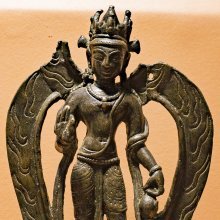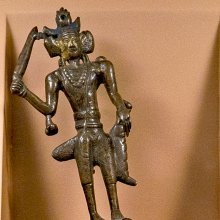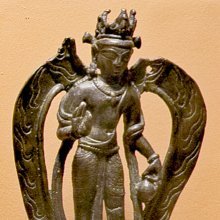Himalaya, Himālaya, Hima-alaya: 20 definitions
Introduction:
Himalaya means something in Buddhism, Pali, Hinduism, Sanskrit, the history of ancient India, Marathi, Hindi. If you want to know the exact meaning, history, etymology or English translation of this term then check out the descriptions on this page. Add your comment or reference to a book if you want to contribute to this summary article.
Images (photo gallery)
(+28 more images available)
In Hinduism
Shaivism (Shaiva philosophy)
Source: Wisdom Library: ŚaivismHimālaya (हिमालय) is a Sanskrit word referring to one of the sixty-eight places hosting a svāyambhuvaliṅga, one of the most sacred of liṅgas according to the Śaivāgamas. The presiding deity residing over the liṅga in this place (Himālaya) is named Rudrarudra. The list of sixty-eight svāyambhuvaliṅgas is found in the commentary of the Jirṇoddhāra-daśaka by Nigamajñānadeva. The word liṅga refers to a symbol used in the worship of Śiva and is used thoughout Śaiva literature, such as the sacred Āgamas.

Shaiva (शैव, śaiva) or Shaivism (śaivism) represents a tradition of Hinduism worshiping Shiva as the supreme being. Closely related to Shaktism, Shaiva literature includes a range of scriptures, including Tantras, while the root of this tradition may be traced back to the ancient Vedas.
Yoga (school of philosophy)
Source: Wisdom Library: YogaHimālaya is one of the eighty-four Siddhas associated with eighty-four Yogic postures (āsanas), according to popular tradition in Jodhpur, Rājasthān. These posture-performing Siddhas are drawn from illustrative sources known as the Nava-nātha-caurāsī-siddha from Vȧrāṇasī and the Nava-nātha-caruāsī-siddha-bālāsundarī-yogamāyā from Puṇe. They bear some similarity between the eighty-four Siddhas painted on the walls of the sanctum of the temple in Mahāmandir.
The names of these Siddhas (e.g., Himālaya) to 19th-century inscription on a painting from Jodhpur, which is labelled as “Maharaja Mansing and eighty-four Yogis”. The association of Siddhas with yogis reveals the tradition of seeing Matsyendra and his disciple Gorakṣa as the founders of haṭhayoga.

Yoga is originally considered a branch of Hindu philosophy (astika), but both ancient and modern Yoga combine the physical, mental and spiritual. Yoga teaches various physical techniques also known as āsanas (postures), used for various purposes (eg., meditation, contemplation, relaxation).
Kavya (poetry)
Source: Shodhganga: The Kavyamimamsa of RajasekharaHimālaya (हिमालय) is the name a locality mentioned in Rājaśekhara’s 10th-century Kāvyamīmāṃsā.—Himālaya is same as Himavān.

Kavya (काव्य, kavya) refers to Sanskrit poetry, a popular ancient Indian tradition of literature. There have been many Sanskrit poets over the ages, hailing from ancient India and beyond. This topic includes mahakavya, or ‘epic poetry’ and natya, or ‘dramatic poetry’.
Ayurveda (science of life)
Nighantu (Synonyms and Characteristics of Drugs and technical terms)
Source: WorldCat: Rāj nighaṇṭuHimālayā (हिमालया) is another name for Bhūmyāmalakī, a medicinal plant identified with Phyllanthus urinaria Linn. (synonym Phyllanthus niruri Hook f.) or “chamber bitter” from the Phyllanthaceae family of flowering plants, according to verse 5.91-93 of the 13th-century Raj Nighantu or Rājanighaṇṭu. The fifth chapter (parpaṭādi-varga) of this book enumerates sixty varieties of smaller plants (kṣudra-kṣupa). Together with the names Himālayā and Bhūmyāmalakī, there are a total of nineteen Sanskrit synonyms identified for this plant.

Āyurveda (आयुर्वेद, ayurveda) is a branch of Indian science dealing with medicine, herbalism, taxology, anatomy, surgery, alchemy and related topics. Traditional practice of Āyurveda in ancient India dates back to at least the first millenium BC. Literature is commonly written in Sanskrit using various poetic metres.
In Buddhism
Tibetan Buddhism (Vajrayana or tantric Buddhism)
Source: Wisdomlib Libary: VajrayoginiHimālaya (हिमालय) is the name of a sacred site (pīṭha) presided over by Khagānanā, according to the vārāhyabhyudaya-maṇḍala. Khagānanā is a deity situated in one of the six petals of the western lotus, of which the presiding deity is kuleśvarī (presiding lady) named Tārā. The central deity of the vārāhyabhyudaya-maṇḍala is the twelve-armed Vajravarāhī.
Himālaya is one of the twenty-four pīṭhas, or ‘sacred-site’ (six lotuses each having six petals), each corresponding with a part of the human body. Himālaya is to be contemplated as situated in the reproductive organs (just as with Pretapurī). Besides being associated with a bodily spot, each pīṭha represents an actual place of ancient India frequented particularly by advanced tantric practitioners
Source: academia.edu: A Critical Study of the Vajraḍākamahātantrarāja (II)Himālaya (हिमालय) is one of the two Upacchandoha (‘sacred spot’) present within the Vākcakra (‘circle of word’) which is associated with the Ḍākinī named Bhūcarī (‘a woman going on the ground’), according to the 9th-centruy Vajraḍākatantra. Vākcakra is one of three Cakras within the Tricakra system which embodies twenty-four sacred spots or districts (viz., Himālaya) resided over by twenty-four ‘sacred girls’ (ḍākinīs) whose husbands abide in one’s body in the form of twenty-four ingredients (dhātu) of one’s body. Himālaya is identified with Himagiri in the Vajraḍākavivṛti.
Himālaya has the presiding Ḍākinī named Khagānanā whose husband, or hero (vīra) is named Virūpākṣa. The associated internal location is the ‘penis’ and the bodily ingredients (dhātu) are the ‘middle of the hair parting’. According to the Vajraḍākavivṛti, the districts Himagiri (Himālaya), Kāñcī, Devīkoṭa and Rāmeśvara are associated with the family deity of Saṃcālinī; while in the Abhidhānottarottaratantra there is the Ḍāka deity named Padmaḍāka standing in the center of the districts named Kaliṅga, Kāñcī, Lampāka and Himālaya (Himagiri).
Source: OSU Press: Cakrasamvara SamadhiHimālaya (हिमालय) is the pīṭha associated with Khagānanā and Virupākṣa, according to the Cakrasaṃvara-maṇḍala or Saṃvaramaṇḍala of Abhayākaragupta’s Niṣpannayogāvalī, p. 45 and n. 145; (Cf. Cakrasaṃvaratantra, Gray, David B., 2007).—The Cakrasaṃvara mandala has a total of sixty-two deities. [...] Three concentric circles going outward, the body, speech and mind wheels (kāya-vāka-citta), in the order: mind (blue), speech (red), and body (white), with eight Ḍākinīs each in non-dual union with their Ḍākas, "male consorts".
Associated elements of Khagānanā and Virupākṣa:
Circle: vākacakra [=vākcakra?] (speech-wheel) (red);
Ḍākinī (female consort): Khagānanā;
Ḍāka (male consort): Virupākṣa;
Bīja: hiṃ;
Body-part: scrot./lab. [scrotum/labia?];
Pīṭha: Himālaya;
Bodily constituent: sīmanta (hair line);
Bodhipakṣa (wings of enlightenment): vīryabodhyaṅga (awakening of effort).
Himālaya (हिमालय) is the name of Upakṣetra (category of holy sites), according to the 10th-century Ḍākārṇava-tantra: one of the last Tibetan Tantric scriptures belonging to the Buddhist Saṃvara tradition consisting of 51 chapters.—Accordingly: “Now, [the Blessed One] has taught [holy sites] such as the kṣetra and upakṣetra in sequence. [...] (3) Kāmarūpa, Oḍra, Triśakuna (for Triśakuni), and Kauśala are the kṣetra [sites]. (4) The upakṣetra [sites] are Kaliṅga, Lampāka, Kāñcī, and Himālaya. [...] Girls who are in these places are of [the nature of] the innate, born in their own birthplaces. [...]”.

Tibetan Buddhism includes schools such as Nyingma, Kadampa, Kagyu and Gelug. Their primary canon of literature is divided in two broad categories: The Kangyur, which consists of Buddha’s words, and the Tengyur, which includes commentaries from various sources. Esotericism and tantra techniques (vajrayāna) are collected indepently.
India history and geography
Source: academia.edu: The Cakrasamvara Tantra (h)Himālaya (हिमालय) is the name of an ancient locality identified with “Mount Kailāsa” according to Nāropāda (11th century A.D.). He is known for identifying unnatural or obscure names mentioned by the Cakrasaṃvara scriptures.

The history of India traces the identification of countries, villages, towns and other regions of India, as well as mythology, zoology, royal dynasties, rulers, tribes, local festivities and traditions and regional languages. Ancient India enjoyed religious freedom and encourages the path of Dharma, a concept common to Buddhism, Hinduism, and Jainism.
Languages of India and abroad
Marathi-English dictionary
Source: DDSA: The Molesworth Marathi and English Dictionaryhimālaya (हिमालय).—m (S hima & ālaya Place.) The Himala or Himalaya range of mountains bounding India on the north, and separating it from Tartary, the Imaus or Emodus of the ancients. It gives rise to the Ganges, the Indus, the Brahmaputra, and many other considerable rivers.
Source: DDSA: The Aryabhusan school dictionary, Marathi-Englishhimālaya (हिमालय).—m The Himalayas.
Marathi is an Indo-European language having over 70 million native speakers people in (predominantly) Maharashtra India. Marathi, like many other Indo-Aryan languages, evolved from early forms of Prakrit, which itself is a subset of Sanskrit, one of the most ancient languages of the world.
Sanskrit dictionary
Source: DDSA: The practical Sanskrit-English dictionaryHimālaya (हिमालय).—
1) the Himālaya mountain; अस्त्युत्तरस्यां दिशि देवतात्मा हिमालयो नाम नगाधिराजः (astyuttarasyāṃ diśi devatātmā himālayo nāma nagādhirājaḥ) Kumārasambhava 1.1.
2) the white Khadira tree. °सुता (sutā) an epithet of Pārvatī.
Derivable forms: himālayaḥ (हिमालयः).
Himālaya is a Sanskrit compound consisting of the terms hima and ālaya (आलय).
Source: Cologne Digital Sanskrit Dictionaries: Shabda-Sagara Sanskrit-English DictionaryHimālaya (हिमालय).—m. (-ya) The Himalaya range of mountains, which bounds India on the north, and separates it from Tartary; the Imaus and Emodus of the ancients, giving rise to the Ganges, and Indus, and many other considerable rivers, and containing the highest elevations in the world: in mythology, the mountain is personified as the husband of Menaka, and the father of Ganga or the Ganges, and Durga or Uma in her descent as Parvati, the mountain nymph, to captivate Siva, and withdraw him from a course of ascetic austerity practised in those regions. E. hima cold, or frost and snow, and ālaya abode.
Source: Cologne Digital Sanskrit Dictionaries: Benfey Sanskrit-English DictionaryHimālaya (हिमालय).—i. e. hima-ālaya, m. The Himālaya range of mountains, [Kumārasaṃbhava, (ed. Stenzler.)] 1, 1.
--- OR ---
Himālaya (हिमालय).—m. the Himālaya range of mountains.
Himālaya is a Sanskrit compound consisting of the terms hima and ālaya (आलय).
Source: Cologne Digital Sanskrit Dictionaries: Cappeller Sanskrit-English DictionaryHimālaya (हिमालय).—[masculine] the Himālaya mountain (abode of snow).
Source: Cologne Digital Sanskrit Dictionaries: Monier-Williams Sanskrit-English Dictionary1) Himālaya (हिमालय):—[from hima > him] a m. ‘abode of snow’, the Himālaya range of mountains (bounding India on the north and containing the highest elevations in the world; in mythology personified as husband of Menā or Menakā [by whom he had a son Maināka] and father of Pārvatī, ‘daughter of the Mountain’, and of Gaṅgā, who, as the personified Ganges, is generally regarded as his eldest daughter), [Bhagavad-gītā; Kāvya literature] etc.
2) [v.s. ...] the white Khadira tree, [cf. Lexicographers, esp. such as amarasiṃha, halāyudha, hemacandra, etc.]
3) Himālayā (हिमालया):—[from himālaya > hima > him] f. Flacourtia Cataphracta, [cf. Lexicographers, esp. such as amarasiṃha, halāyudha, hemacandra, etc.]
4) Himālaya (हिमालय):—[from hima > him] b [Nominal verb] [Parasmaipada] yati, to resemble the Himālaya, [Dhūrtasamāgama]
Source: Cologne Digital Sanskrit Dictionaries: Yates Sanskrit-English DictionaryHimālaya (हिमालय):—[himā+laya] (yaḥ) 1. m. Himālaya range personified as the husband of Menakā and father of the Ganges.
[Sanskrit to German]
Sanskrit, also spelled संस्कृतम् (saṃskṛtam), is an ancient language of India commonly seen as the grandmother of the Indo-European language family (even English!). Closely allied with Prakrit and Pali, Sanskrit is more exhaustive in both grammar and terms and has the most extensive collection of literature in the world, greatly surpassing its sister-languages Greek and Latin.
Hindi dictionary
Source: DDSA: A practical Hindi-English dictionaryHimālaya (हिमालय) [Also spelled himalay]:—(nm) the Himalayas.
...
Kannada-English dictionary
Source: Alar: Kannada-English corpusHimālaya (ಹಿಮಾಲಯ):—[noun] the Himalayan range of mountains.
Kannada is a Dravidian language (as opposed to the Indo-European language family) mainly spoken in the southwestern region of India.
See also (Relevant definitions)
Starts with (+10): Himalaya deutzia, Himalaya-parvata, Himalaya-pradesha, Himalayagriha, Himalayan ash, Himalayan astragalus, Himalayan bird cherry, Himalayan bladder senna, Himalayan blue poppy, Himalayan box, Himalayan boxwood, Himalayan boxwood tree, Himalayan cedar, Himalayan fir, Himalayan hemlock, Himalayan laburnum, Himalayan larkspur, Himalayan manna ash, Himalayan mistletoe, Himalayan mulberry.
Ends with: Great Central Himalaya, Lesser Himalaya, Rudrahimalaya.
Full-text (+1353): Himacāla, Kailasa, Tusharagiri, Naubandhana, Adrisha, Himadri, Himavat, Himaprastha, Shailapati, Aryavarta, Haimavata, Himashaila, Shailendra, Udagadri, Hima, Himavan, Tuhinashaila, Himagiri, Madhyadesha, Himavanta.
Relevant text
Search found 196 books and stories containing Himalaya, Himālaya, Hima-alaya, Hima-ālaya, Himālayā, Hima-ālayā; (plurals include: Himalayas, Himālayas, alayas, ālayas, Himālayās, ālayās). You can also click to the full overview containing English textual excerpts. Below are direct links for the most relevant articles:
Kavyamimamsa of Rajasekhara (Study) (by Debabrata Barai)
Appendix 2 - Identification of Geographical names mentioned in the Kāvyamīmāṃsā
Part 8.3 - Rājaśekhara’s concepts of Bhāratavarṣa (undivided india) < [Chapter 5 - Analyasis and Interpretations of the Kāvyamīmāṃsā]
Part 8.4 - The region of Pūrvadeśa (eastern part) < [Chapter 5 - Analyasis and Interpretations of the Kāvyamīmāṃsā]
Garga Samhita (English) (by Danavir Goswami)
Verse 2.2.11 < [Chapter 2 - Description of Girirāja Govardhana’s Birth]
Verse 6.14.23 < [Chapter 14 - The Glories of Ratnākara, Raivata, and Kācala]
Verses 6.14.19-20 < [Chapter 14 - The Glories of Ratnākara, Raivata, and Kācala]
Rig Veda (translation and commentary) (by H. H. Wilson)
Rig Veda 5.61.19 < [Sukta 61]
The Devi Bhagavata Purana (by Swami Vijñanananda)
Chapter 31 - On the Birth of Pārvatī in the House of Himālayās < [Book 7]
Chapter 8 - On the extinction of the family of Yadu and on the anecdote of Parīkṣit < [Book 2]
Chapter 2 - On the conversation between Nārada and the Bindhya Mountain < [Book 10]
The Jataka tales [English], Volume 1-6 (by Robert Chalmers)
Jataka 312: Kassapamandiya-jātaka < [Volume 3]
Jataka 323: Brahmadatta-jātaka < [Volume 3]
Jataka 328: Ananusociya-jātaka < [Volume 3]
The Shiva Purana (by J. L. Shastri)
Chapter 22 - The dalliance of Śivā and Śiva on the Himālayas < [Section 2.2 - Rudra-saṃhitā (2): Satī-khaṇḍa]
Chapter 5 - The nineteen incarnations of Śiva < [Section 3 - Śatarudra-saṃhitā]
Chapter 23 - Attempt of Himavat to dissuade Pārvatī; gods go to meet Śiva < [Section 2.3 - Rudra-saṃhitā (3): Pārvatī-khaṇḍa]
Related products
(+80 more products available)
